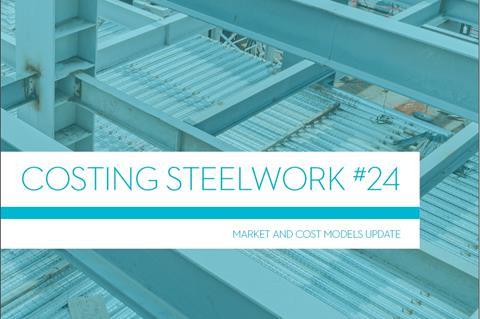- News

All the latest updates on building safety reformRegulations latest
- Focus
- Home
- News
- Focus
- Comment
- Events
- CPD
- Building the Future
- Jobs
- Data
- Subscribe
- Building Boardroom
Costing Steelwork 24: Market update
Sponsored by Steel For Life

A market update from Aecom, BCSA and Steel for Life that provides guidance on costing structural steelwork

Construction sector sentiment saw a bounce going into the new year. The jump reflected the on-going good overall levels of workload across the industry and most areas of the country. The output trend, which the sentiment readings reflect, are supported by Office for National Statistics data that underscores the reasonable activity still in the industry. The sideways move in output volume over recent months does raise a question about underlying momentum and which direction the output trend will next take. With the gathering data – anecdotal and evidenced – sentiment is very likely to remain at or near a neutral level for a little while yet. Until now the construction sector has offered a relatively stable workload environment while other economic sectors face headwinds.
Construction new work output increased by 4.6% over the 12 months to Q4 2022, according to the latest data release from the Office for National Statistics. Looking into the monthly data points, there are discernible indications that the new work output trend is wavering and possibly reaching a crescendo. Seasonal effects might explain the notable overall drop in January of new work output since the months making up the fourth quarter; however, the January to February movement saw something of a reversal, with a small improvement in recorded volume. Some sizeable revisions to the 2022 data helped to improve the numbers for the year and push total output above its pre-pandemic level, although new work output is still to meet this threshold.
Market surveys reflect the tepid economic environment and the unclear – questionable, even – outlook for 2023. Household incomes are feeling the effects from higher energy costs, real terms pay reduction because inflation is so high, and a significantly higher interest rate environment than 12 months ago when the bank base rate was just 0.5%. Consumer spending has been subdued as the cost of living strains take hold. If the economy is still not as bad as initially feared, this offers little respite from the higher cost financing environment. Given the UK economy’s reliance on services and consumer spending, the prospect of an overall low growth environment across 2023 remains more likely than not.
Read more…
Already registered? Login here
To continue enjoying Building.co.uk, sign up for free guest access
Existing subscriber? LOGIN
Stay at the forefront of thought leadership with news and analysis from award-winning journalists. Enjoy company features, CEO interviews, architectural reviews, technical project know-how and the latest innovations.
- Limited access to building.co.uk
- Breaking industry news as it happens
- Breaking, daily and weekly e-newsletters
Get your free guest access SIGN UP TODAY

Subscribe now for unlimited access
Subscribe to Building today and you will benefit from:
- Unlimited access to all stories including expert analysis and comment from industry leaders
- Our league tables, cost models and economics data
- Our online archive of over 10,000 articles
- Building magazine digital editions
- Building magazine print editions
- Printed/digital supplements
Subscribe now for unlimited access.
View our subscription options and join our community


















